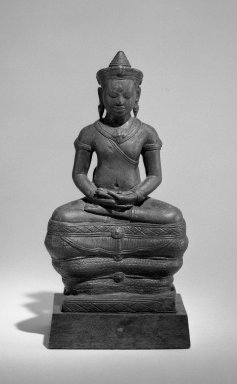
Artist:Khmer
Medium: Bronze
Geograhical Locations:
Dates:ca. 12th century
Dimensions: 7 11/16 x 3 1/4 x 2 3/8 in. (19.5 x 8.3 x 6 cm)
Collections:
Accession Number: 71.166
Image: 71.166_bw.jpg,
Catalogue Description: A small image of a Buddha seated in the posture of meditation (Dhyanasana) on the coils of the serpent Muchalinda. The multi-headed hoods of the snake, which originally sheltered the figure, and which was cast as a separate piece, is now missing. The Buddha is adorned with all the princely ornaments, such as the crown, earrings, necklace, armlets, wristlets and anklets. The iconography of the figure presents a problem. It is possible that this stele may represent the Buddha of Healing, Bhaisajyaguru, who is the only Buddha mentioned in the epigraphy of Khmer ruler Jayavarman VII, and who was apparently quite popular during his reign (Boisselier, Le Cambodge, Manuel d'Archaeologie d'Extreme-Orient, Pt. 1: Asie du Sud-East, vol. 1, Paris 1966, p. 301). The flask with a slightly painted top in the upturned pal of this Buddha's right hand, which is a symbol of Bhaisajyaguru, may speak in favor of this theory. On the other hand, this jar appears in the hands of Buddhas on many occasions and is not sufficient to make a definite iconographical attribution (see Margaret Marcus, "Buddha sheltered by Mucalinda," The Cleveland Museum Bulletin, p. 185) the presence of the naga in these figures may symbolize the protective power associated with serpents (ibid pp. 186-7). The figure is a portable image in the round (chala chitra) and can be viewed from all sides. Condition: snake hood missing. Bronze had slight traces of bronze disease around the face and neck. See restoration report 7/89.